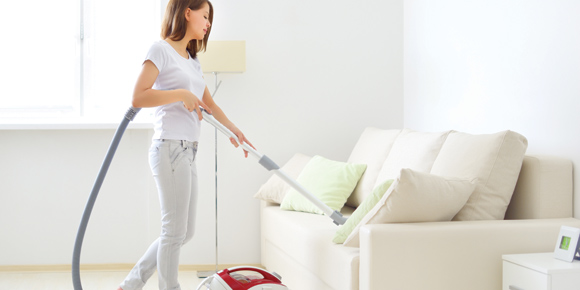By Stephanie Booth
Attention, couch potatoes! Time to learn how to clean that sofa you’re planted on. Think about it: If your favorite oft-used seating arrangement is like most people’s, it is semi-regularly subjected to sweaty socks, cracker crumbs, dog paws, cat hair, spilled juice (or wine), as well as everyday dust and detritus.
As such, cleaning your couch is a household chore that really isn’t optional, and should happen far more often than you may think.
“People don’t want to hear it, but a big part of cleaning is frequency,” says Debra Johnson, home cleaning expert for Merry Maids. “If you just have one or two people in your house and no pets, you can probably get by with only cleaning your couch once a month or every other month.”
Bet you thought we were going to say once a year, huh? And if you’re part of a typical household, including the pets and maybe the children, “I hate to say it,” says Johnson, “but you should clean your couch at least every two weeks.”
Which likely means your sofa’s long overdue.
Still, it’s not like you can simply drag a sectional into the shower and give it a good scrubbing. (If only!) So how do you clean the pièce de résistance of your living/family/game room?
Consider this your couch-cleaning primer.
Know how to decipher
couch cleaning codes
Not all couch-cleaning regimens are created equal; what works for full-grain leather won’t necessarily be best for, say, velvet. Somewhere on your sofa, you’ll find a tag with what’s called an upholstery cleaning code. Learn it, know it, live it. This is crucial info about what you do next. (Can’t find your tag? Contact the manufacturer.)
The four most common cleaning codes:
S: Clean only with a solvent cleaner. This means you should apply a special dry-cleaning product or water-free solvent to your couch with a white cloth. (Spot-check an inconspicuous place first.) Blot, don’t rub away any dirt.
W: Clean only with a water-based cleaner. Use a damp microfiber cloth to remove dust and dirt. If your couch is microfiber, a stiff bristle brush (like horsehair) will work well, too.
X: No cleaners at all! Since an “X” couch can’t get wet, you’ll have to make the most of vacuuming and brushing. Big stains will mean calling a dry-cleaning pro.
W/S: Use a water-based or solvent cleaner. Consider this the “O-positive” of couch care. The fabric is so easy-going, you can use either of the above techniques.
Got that down? Here’s what to do next, based on your couch type.
Vacuum first
For starters, you’ve got to get rid of the gunk sitting on the outer surface of your furniture. The best tool for that job is your vacuum. But don’t just plop the entire thing directly onto your cushions. Take advantage of your vacuum’s hose attachment.
“It has easier maneuverability, plus the smaller passes it makes suck up more dirt,” says Johnson. First vacuum the sofa itself, then every side of the cushions. And don’t forget the exterior. “If you have pets, they probably rub up against it,” Johnson notes.
Experiment with a crevice tool, as well. Who knows what you might find in between the cushions? “I’ve seen all kinds of things,” says Johnson. “Checks, money, glasses…”
Remove pet hair
Not all vacuums are adept at removing stubborn dog and cat hair. For that task, Leslie Reichert, cleaning couch and author of “The Joy of Green Cleaning,” suggests putting on a rubber glove, then wiping your hand over your couch pillows and cushions. “The rubber creates static and pulls the hair right off,” she says.
You can also try pressing down, then carefully pulling off, strips of masking tape, says Johnson. But be careful. If you’ve got a delicate fabric, the tape could damage it.
Remove stubborn pet odors
No one likes their couch to smell like dog, no matter how much you adore yours. If your couch fabric can take some moisture, when things start to go funky, “spray your couch with a very light mist of vodka,” says Reichert. “The alcohol will evaporate and when it does, will remove odors.”
Keep your couch fresh
In between cleanings, flip your seat cushions to prevent signs of wear. If you can, switch their positions as well. Sprinkling a little baking soda will help remove some musty smells, but go easy on the amount and only apply it to the nooks and crannies underneath the cushions. “If you put it on top of the cushions, it could lighten the color of your fabric,” Reichert says.
Stock up on club soda
Let club soda become your couch’s new best friend. (So long as your couch is a “W” or “W/S.”) When that red wine or cup of chicken soup spills, dampen a white cloth with the soda and go over the spill. “Don’t spray or pour it directly on the couch,” cautions Reichert. “That will leave a ring.”
Make couch care a routine
“We tend to wait to clean until we see something, like a spill,” says Johnson. But your couch deserves more attention. Create a care routine and commit to it. A little preventive cleaning can make your couch look (and smell) better, so that it can continue to be sprayed with your cracker crumbs and muddy dog paws for years to come.
— realtor.com



